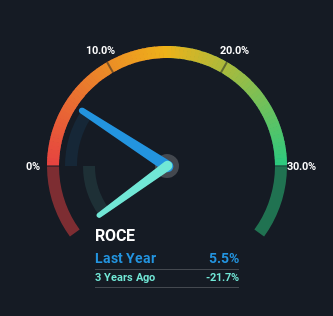Nihon Seimitsu (TSE:7771) Might Have The Makings Of A Multi-Bagger
To find a multi-bagger stock, what are the underlying trends we should look for in a business? Typically, we'll want to notice a trend of growing return on capital employed (ROCE) and alongside that, an expanding base of capital employed. Put simply, these types of businesses are compounding machines, meaning they are continually reinvesting their earnings at ever-higher rates of return. So on that note, Nihon Seimitsu (TSE:7771) looks quite promising in regards to its trends of return on capital.
What Is Return On Capital Employed (ROCE)?
If you haven't worked with ROCE before, it measures the 'return' (pre-tax profit) a company generates from capital employed in its business. The formula for this calculation on Nihon Seimitsu is:
Return on Capital Employed = Earnings Before Interest and Tax (EBIT) ÷ (Total Assets - Current Liabilities)
0.055 = JP¥99m ÷ (JP¥5.7b - JP¥3.9b) (Based on the trailing twelve months to December 2023).
So, Nihon Seimitsu has an ROCE of 5.5%. On its own, that's a low figure but it's around the 4.8% average generated by the Luxury industry.
View our latest analysis for Nihon Seimitsu

While the past is not representative of the future, it can be helpful to know how a company has performed historically, which is why we have this chart above. If you're interested in investigating Nihon Seimitsu's past further, check out this free graph covering Nihon Seimitsu's past earnings, revenue and cash flow.
The Trend Of ROCE
It's great to see that Nihon Seimitsu has started to generate some pre-tax earnings from prior investments. The company was generating losses five years ago, but now it's turned around, earning 5.5% which is no doubt a relief for some early shareholders. Additionally, the business is utilizing 54% less capital than it was five years ago, and taken at face value, that can mean the company needs less funds at work to get a return. The reduction could indicate that the company is selling some assets, and considering returns are up, they appear to be selling the right ones.
On a side note, we noticed that the improvement in ROCE appears to be partly fueled by an increase in current liabilities. Effectively this means that suppliers or short-term creditors are now funding 68% of the business, which is more than it was five years ago. And with current liabilities at those levels, that's pretty high.
Our Take On Nihon Seimitsu's ROCE
From what we've seen above, Nihon Seimitsu has managed to increase it's returns on capital all the while reducing it's capital base. Given the stock has declined 37% in the last five years, this could be a good investment if the valuation and other metrics are also appealing. With that in mind, we believe the promising trends warrant this stock for further investigation.
If you'd like to know more about Nihon Seimitsu, we've spotted 3 warning signs, and 1 of them is concerning.
While Nihon Seimitsu may not currently earn the highest returns, we've compiled a list of companies that currently earn more than 25% return on equity. Check out this free list here.
Valuation is complex, but we're here to simplify it.
Discover if Nihon Seimitsu might be undervalued or overvalued with our detailed analysis, featuring fair value estimates, potential risks, dividends, insider trades, and its financial condition.
Access Free AnalysisHave feedback on this article? Concerned about the content? Get in touch with us directly. Alternatively, email editorial-team (at) simplywallst.com.
This article by Simply Wall St is general in nature. We provide commentary based on historical data and analyst forecasts only using an unbiased methodology and our articles are not intended to be financial advice. It does not constitute a recommendation to buy or sell any stock, and does not take account of your objectives, or your financial situation. We aim to bring you long-term focused analysis driven by fundamental data. Note that our analysis may not factor in the latest price-sensitive company announcements or qualitative material. Simply Wall St has no position in any stocks mentioned.
About TSE:7771
Nihon Seimitsu
Manufactures and sells watch bands and exterior parts, spectacle frames, and other products in Japan.
Adequate balance sheet and fair value.
Market Insights
Community Narratives



